| |
|
2. TRUKU
Weaving Process |
|
[Ramie
growth]
[Ramie
cutting]
[yarn
making]
[yarn
swinging]
[sunning]
[yarn
twisting]
[yarn
rolling]
[yarn
spinning]
[thread
cooking]
[thread
washing]
[thread
dyeing]
[sunning]
[thread
neatening]
[routing]
[weaving] |
|
(1)
Ramie growth |
|
Ramie growth
can be described as follows: if
starting from root, the ramie
grows bud about 2-3 weeks later,
according to the fertilizing
situation of soil and planting
time; break the stick above the
root when the height reaches
15-20 cm or around and fertilize
then; extracted ramie yarn
becomes tough until the ramie
stick gets mature and presents
brown, so that harvested ramie
in the thrid or fourth round are
useful as growed from the root
and 2-3 times of rammie cutting
(mature and brown in color ->
ramie cutting process) are
required before harvesting ramie
and making them to be weaving
materials, which is about 6-8
months. For those have been
grown in fields for a long time,
mature process do not take too
long, enable to harvest once a
quarter and 3-4 times a year.
|
|
(2)
Ramie cutting |
|
Generally,
ramie cutting should be done by
female and forbiddens male
participation, starting from
processing ramie leaves, when
harvesters would cut down sticks
above root with reaphook while
grasping about 10-15 sticks at
the bottom adown the part with
leaves, and get rid of leaves
with the back of reaphook.
   Process
of ramie cutting Process
of ramie cutting |
 |
 |
 |
cut the bottom of
ramie stick |
get rid of leaves |
take all ramie sticks |
|
|
|
|
|
|
(3) Making ramie yarn by
peeling off bark |
|
Ramie stick
should be peeled off. The
operator should sit with two
legs straight, fixing 2-3 ramie
sticks (suggest using 1 stick
for greed hand) at the end by
crossing thumbs of the feet
while breaking sticks by hands
(at two third spot of the
stick). When the stick breaks
but the cortex keeps connected,
scratch the surface with ramie
scratching tool made of bamboo,
leaving fibre (presenting
white), which is not an easy
job, requiring use of both hands
and feet, as well as waist
power. The job was operated by
women then and men were
forbidden in assistance. If
ramie coverage was wide, people
would collectively cooperate to
accomplish the job by means of
“job shift”.
   Process
of ramie yarn making Process
of ramie yarn making |
 |
 |
 |
 |
 |
|
prepare ramie scratching
tool before making yarn |
Break sticks |
take ramie cortex when
breaking sticks |
repeat cortex
scratching using hands
and feet |
roll yarn in palm. |
|
|
|
|
|
|
|
|
(4) Swing yarn to get rid
off impurity |
|
Peeled ramie becomes fibre,
named as ramie yarn that should
heavily beated the stone to get
rid of the residue and obtain
products with better qualtiy.
|
|
(5) Sunning |
|
After beating yarn, put ramie
yarn on hawat by bundle for
sunning that makes the fibre
tougher and gets rid of the
water for handy delivery.
|
|
(6) Yarn twisting |
|
Bite one end
of ramie yarn with incisors,
decompose ramie yarn by hands,
and connect them by section in
the way of twisting in hands.
Takd off yarn when the palm is
full and bind them in the middle
which is called “Bkuul”.
The other way
refers to first encircling thin
sisal rope around one’s neck
while binding ramie yarn with
sisal rope (instead of incisor
as a more hygenic way), and then
following above operation, which
explains why women then usually
have think sisal rope around
neck. It serves as tools as well
as a representation of a
“hardworking woman”. Yarn
twisting is time consumption, so
Truku women know how to utilize
time efficiently, who would
twist while walking to and
returning from fields or other
destinations.
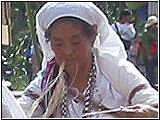 |
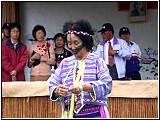 |
 |
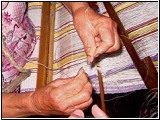 |
|
twist yarn with mouth |
not twist yarn with
mouth (put twine around
neck) |
decompose ramie yarn |
rub, twist and connect
yarn in palm |
|
|
(7) Yarn rolling |
|
Revolve the
twist stick and encicle ramie
yarn with the revolving stick
with diameter about 10-20 cm.
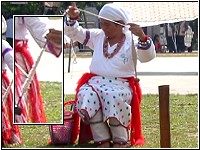 |
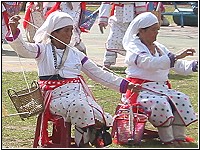 |
|
encircle twist stick
around ramie yarn |
pack ramie yarn (put in
back-basket) |
|
|
|
|
|
(8) Yarn spinning (spindle) |
|
Weaving with
spindle, the movement of which
is convenient for the next
process; ensure ramie yarn to be
neat after complex process like
handy cooking, sunning, washing
and dyeing.
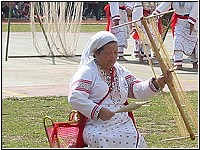 |
|
Encircle
twist stick around ramie
yarn |
|
|
(9) Thread cooking
(bleaching) |
|
Stir ramie
thread and charcoal ash water
and cook them in pot, buring
wood in the past. Be cautious of
the fire. If it is too big,
bleaching process may fail,
because the cooked ramie thread
would be heated uneven. Cooking
process lasts about 3 hours, the
completion of which should
depend on the softness and
bleached level of ramie. To
check the bleached level, we can
take part of ramie out from pot,
and rub and wash them with clean
water, when the part may present
white.
   Process
of ramie thread cooking Process
of ramie thread cooking |
 |
 |
 |
 |
 |
|
Make fire in the stove |
Cook charcoal ash water
in the pot |
Get another basin of
charcoal ash water |
Take sunned ramie yarn |
Stir with charcoal ash
water |
 |
 |
 |
 |
 |
|
Charcoal water starts
boiling |
Put stirred ramie
yarn in |
Put charcoal water to
about 90 percent full |
Cover the lid and cook
for 3 hours |
Until the water is
vaporized |
|
|
|
|
|
|
|
|
(10)
Thread washing |
|
Thread
washing purposes to get rid of
residues and black soil from
ramie thread and make them
whiter. Thread washing requires
plenty of clean water, and
experienced weavers would use
brook nearby (fluid and clear)
to take residue and black soil
away from the thread, which is
evident of better effect than
washing at home. Accessing to
water was not handy in the past,
as some interviewees mentioned
that before actually learning
weaving skills, they had to
obtain water from the source
after woken up by elderlys early
in the morning, which should
reveal direct relationship
between thread wash and plenty
of water.
|
|
(11) Thread dyeing |
|
Traditionally
Truku does not have much
impregnant but just red and
black, leaving weaving thread
with three colors:
white, black
and red.
Red: chop corm of dioscorea ehipogoniordes got
from the field, rub and stir
them with ramie thread to infuse
the color into thread, and
eventually the thread turns to
red. Black: adopting leaves of
Lagerstroemia subcostata is one
of dyeing methods, embeding
dipped ramie thread in paddy
field for 1-2 days, which would
present black after cleaned.
White: thread cooking bleaches
it.
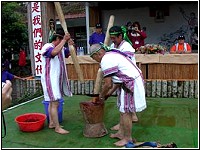 |
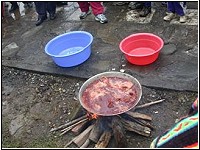 |
|
Extract of corm of
Dioscorea ehipogoniordes
after chopped |
Cook ramie thread
dipping in extract of
Dioscorea ehipogoniordes |
|
|
|
|
(12)
Sunning |
|
After dipping
and cleaning, place thread on
bamboo shelf outdoors for
sunning, lasting about 1-2
weeks.
|
|
(13) Neaten thread |
|
During
sunning, neatening thread is
necessary to check if ramie
thread is broken or messed
together, and solve the
problems.
|
|
(14)
Routing
|
|
Encircle
ramie thread around routing
frame accroding to needed figure
and color, effort on which
decides the success of works.
|
|
(15) Weaving (weaving methods) |
|
The Truku
weaving method spends lots of
time on previous 14 steps, but
the actual time consuming and
testing step just starts. It is
said that weaving method and
process decide the looking of
final work, because nice and
durable work depends on the
texture. Generally speaking,
Truku has five weaving methods,
including tabby, diagonal,
diamond, anthemion, and rick-like
or float weaving, which will be
briefly introduced as follows.
Tabby
weaving: is regarded as
the simplest and most
disciplined weaving method, and
can be used to weave a large
piece as well as accompanied
with different colors (only red
and black were available in the
past) to form stripes.
Basically, tabby cloth is used
to make coverlet and tablecloth,
or carry babies.
Diagonal
weaving: the method and
routing are different from tabby
weaving, but can be learnt
quickly if one studyeing hard.
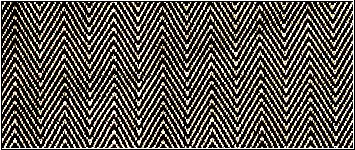 |
|
Image source:
Traditional Atayal Sediq
Weaving Culture,
by Tiemi·
Nawei (Zeng,
Ruilin) |
Diamond
weaving: the weaving
method and routing are the same
with diagonal weaving. The
process adopts diagonal first,
and then uses weaving tools
(thread heddle rod and
separating rod) in turn which is
called “reverse” production
method.
 |
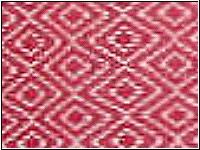 |
|
Source of works:Yusi•Yutaw
Daughter of A-hsueh
Liang Li |
Partial magnification of
left picture |
Float
weaving (rice-like method):Float
weaving has the same routing
methoud with tabby weaving,
drawing figure with thread
drawing rod and requiring many
separating rods. As mentioned in
the weaving meaning, those who
want to pass rainbow bridge
should know how to operate
weaving of miri ratuk and pala
msabung.
|
|
|